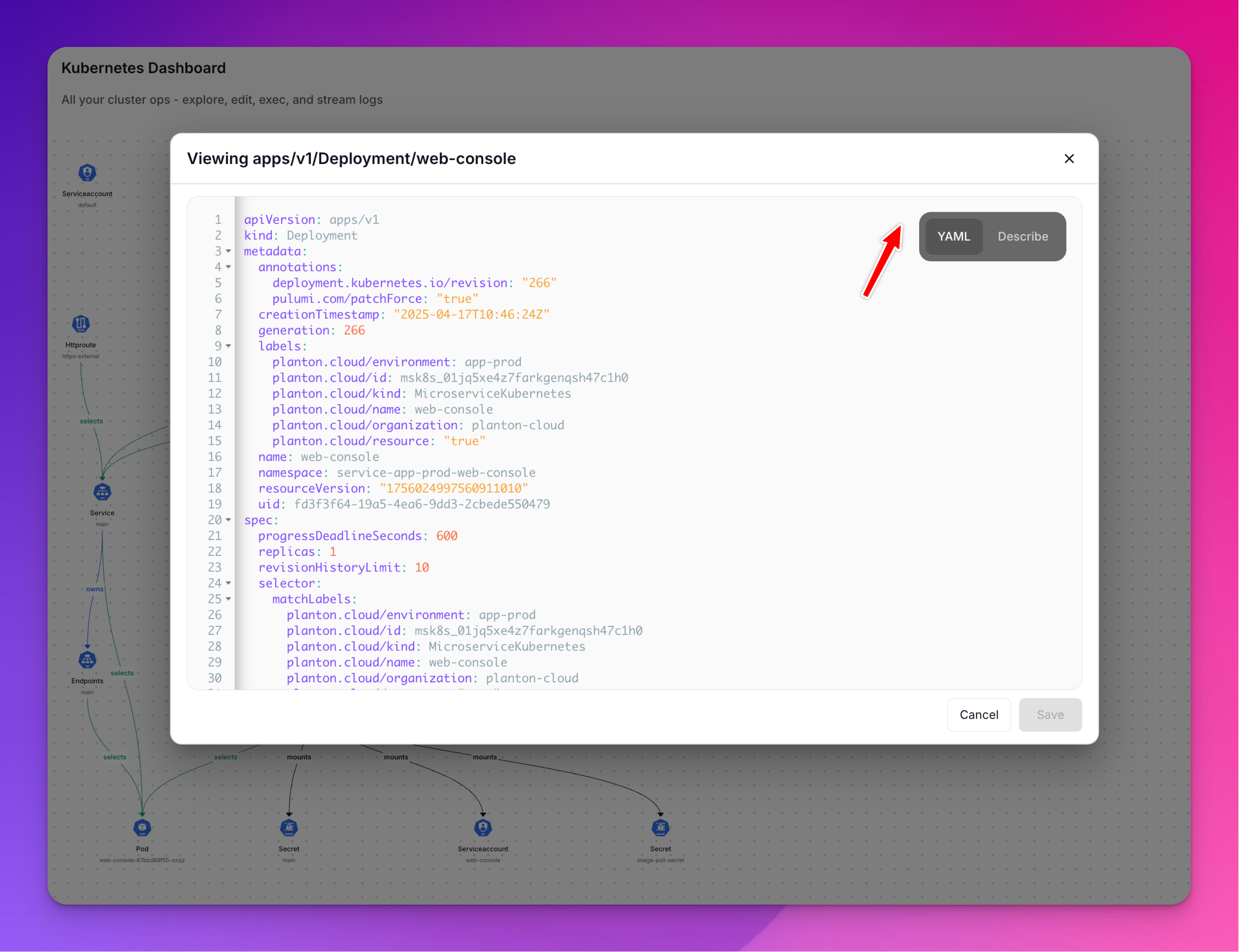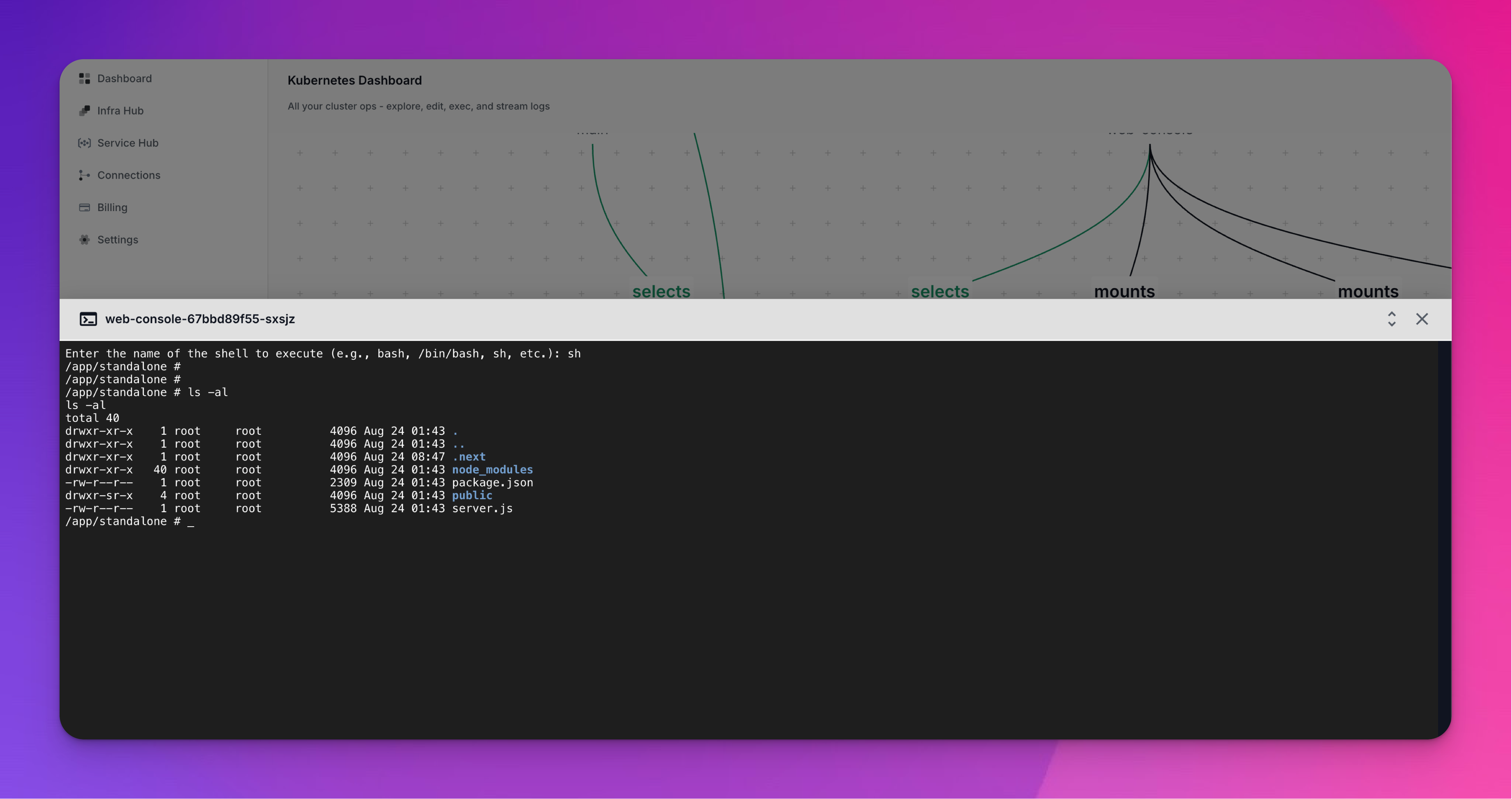Kubernetes Dashboard
Kubernetes Dashboard
So you've deployed your service. Now what? Traditional Kubernetes operations often mean wrestling with kubectl, managing kubeconfig files, and navigating overwhelming cluster-wide views. Planton Cloud changes this with an intuitive dashboard that makes post-deployment operations as simple as the deployment itself.
What You'll Learn
In this guide, you'll discover how to:
- Navigate the Kubernetes Dashboard for your deployed services
- View and edit Kubernetes resources directly from your browser
- Execute commands inside running pods without kubectl
- Understand resource relationships through visual DAG views
The Developer-Friendly Kubernetes Experience
After your service deploys, you'll notice a Kubernetes icon in the details pane. This icon appears not just for services, but for any Planton Cloud resource (Lego block) deployed to Kubernetes. Click it, and welcome to a whole new way of interacting with your deployments.
![]()
Service-Scoped Views
Unlike traditional Kubernetes dashboards that show everything in a cluster, Planton Cloud's dashboard is intelligently scoped:
The key insight: Show developers only what matters to their service, not the entire cluster.
This approach:
- Reduces cognitive overload
- Makes relationships between resources clear
- Helps developers understand their service architecture
- Prevents accidental changes to unrelated resources
The DAG Canvas
When you open the Kubernetes Dashboard, you're greeted with a directed acyclic graph (DAG) showing all Kubernetes resources created for your service. The interactive visual graph displays your resources and their relationships:

Each node in the graph represents a Kubernetes resource, with lines showing dependencies and relationships. This visual representation makes it immediately clear how your service is structured in Kubernetes. The actual dashboard provides an interactive experience where you can click on each node to explore and manage resources.
Resource Actions
Click on any resource node to reveal available actions:
![]()
For All Resources
- View Details: See
kubectl describeoutput and full YAML - Edit: Modify the resource YAML directly in your browser
- Delete: Remove the resource (with confirmation)
Pod-Specific Actions
- Exec Into Pod: Open a shell inside the container
- Stream Logs: View real-time logs from the pod
- View Container Details: Inspect container-specific configuration
![]()
Day 2 Operations Made Simple
Viewing Resources
Click the "View" action on any resource to see:
- Describe Output: The same information you'd get from
kubectl describe
Name: my-service-deployment-abc123
Namespace: production
Labels: app=my-service
version=v1.2.3
Annotations: deployment.kubernetes.io/revision: 3
- Full YAML: The complete resource definition in YAML format

Editing Resources
Need to make a quick change? The edit feature lets you:
- Modify the YAML directly in the browser
- Validate changes before saving
- Apply updates immediately
- See the results in real-time
Common edits include:
- Adjusting resource limits
- Adding environment variables
- Updating labels or annotations
- Modifying replica counts
Executing Commands in Pods
One of the most powerful features is browser-based pod access:
- Select a Pod: Click on any pod node
- Choose "Exec": Opens the exec dialog
- Pick Container: Select which container (if multiple)
- Select Shell: Choose bash, sh, or another available shell
- Run Commands: Full terminal access in your browser

Example use cases:
# Check environment variables
env | grep DATABASE
# Verify file systems
ls -la /app/config
# Test internal connectivity
curl http://other-service:8080/health
# Debug application state
cat /tmp/debug.log
No kubectl required. No kubeconfig to manage. Just click and debug.
Benefits for Developers
1. Zero Setup Required
- No kubectl installation
- No kubeconfig management
- No cluster access configuration
- Works from any browser
2. Contextual Understanding
- See only your service's resources
- Understand relationships visually
- Learn Kubernetes concepts gradually
- Make changes with confidence
3. Rapid Debugging
- Exec into pods instantly
- View logs in real-time
- Edit configurations on the fly
- See changes take effect immediately
Security & Access Control
The Kubernetes Dashboard respects Planton Cloud's IAM policies:
- Users only see services they have access to
- Actions are limited by user permissions
- All changes are audited
- Dangerous operations require confirmation
Common Workflows
Debugging a Failing Pod
- Open the Kubernetes Dashboard
- Find the red/failing pod in the DAG
- Click "Stream Logs" to see error messages
- Use "Exec" to investigate further
- Edit the Deployment to fix issues
Scaling Your Service
- Click on the Deployment node
- Select "Edit"
- Change
spec.replicasvalue - Save and watch new pods appear
Updating Configuration
- Find the ConfigMap or Secret
- Click "Edit"
- Modify values as needed
- Pods automatically restart with new config
Coming Soon
Planton Cloud is extending this experience beyond Kubernetes:
AWS ECS Dashboard
- Task and service visualization
- Container instance management
- Log streaming from CloudWatch
- Task definition editing
GCP Cloud Run Dashboard
- Revision management
- Traffic splitting controls
- Metric visualization
- Direct log access
Enhanced Observability
- Resource utilization metrics
- Cost transparency for deployed resources
- Health check monitoring
- Performance metrics and alerts
- Post-deployment cloud visualization
Best Practices
Use the Dashboard for:
- Quick debugging and troubleshooting
- Understanding service architecture
- Making temporary changes for testing
- Learning how Kubernetes works
Continue Using Git for:
- Permanent configuration changes
- Environment promotions
- Audit trail and compliance
- Team collaboration
Troubleshooting
Dashboard Won't Load
- Verify you have access to the service
- Check that the service is deployed to Kubernetes
- Ensure your browser allows pop-ups
Can't Exec Into Pod
- Confirm the pod is running
- Check that the container has a shell installed
- Verify your IAM permissions include exec access
Edit Changes Don't Persist
- Remember that manual edits may be overwritten by deployments
- For permanent changes, update your
_kustomizeconfiguration - Use Git-based workflows for production changes
Next Steps
See Also
Based on: planton.ai/workspace/transcripts/service-hub/service-ops.transcript.md
Next article
